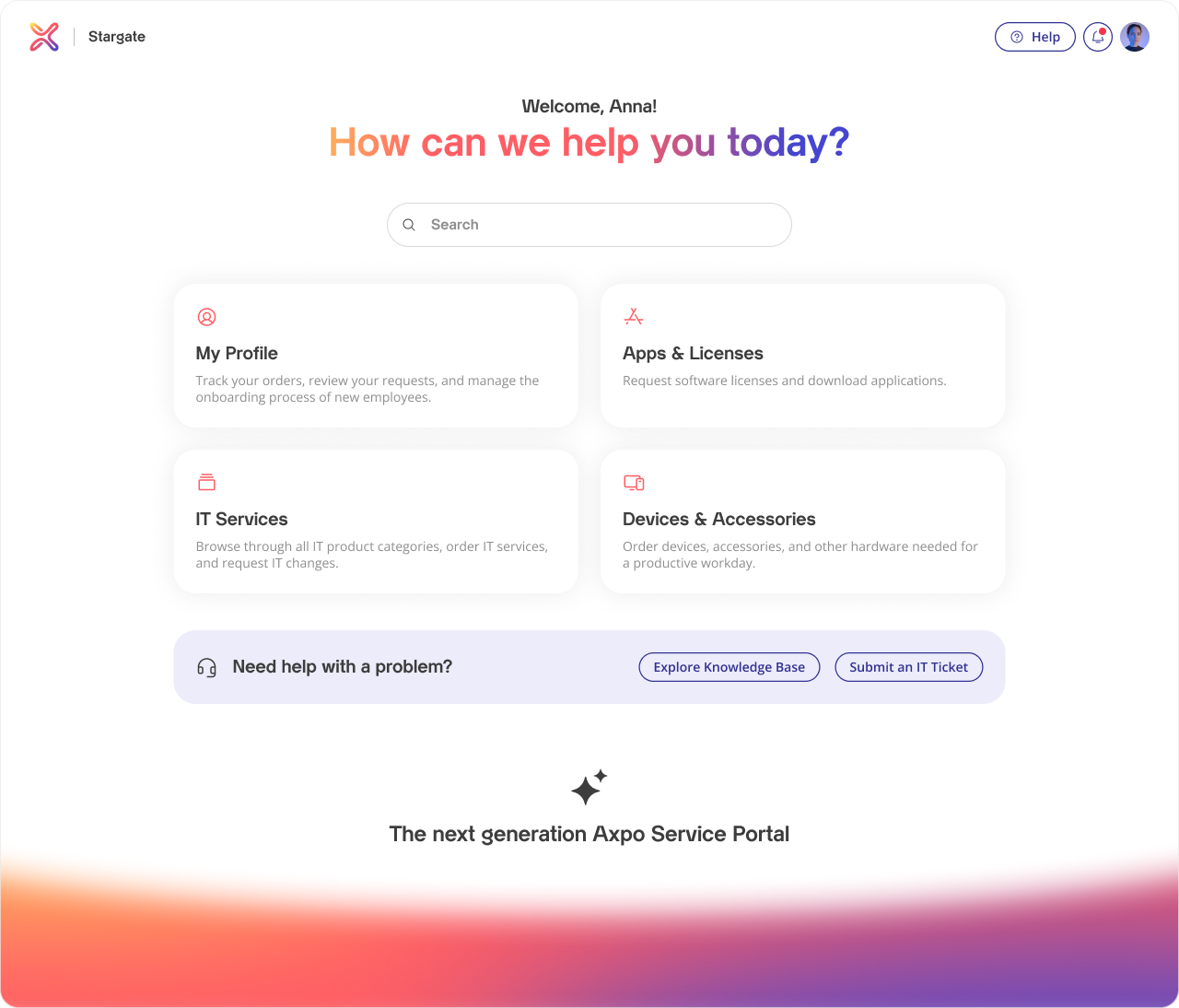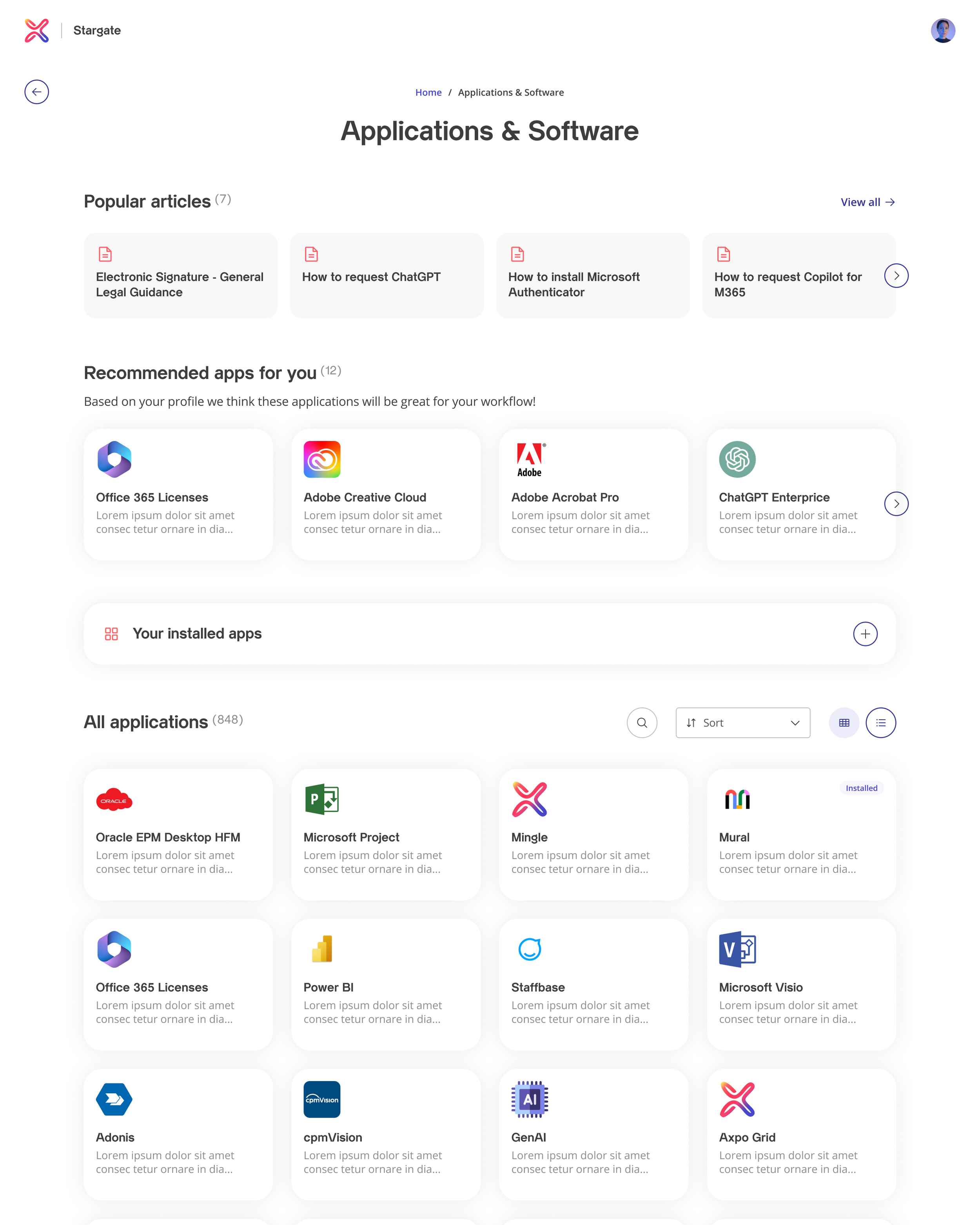Stargate
Stargate is Axpos’ Next Generation Service Portal. A seamless, user-centred digital portal where employees can access everything they need from IT, HR, and Facilities management, without friction, confusion, or delays.
Company: Axpo
Date: 2024 - 2026
Role: Initiative & UX Lead
Format: Web Application

Context & Challenge
At Axpo, Users were increasingly frustrated by fragmented systems, unclear processes, and a lack of centralised access. Navigating existing portals to request services, order hardware, or manage application access had become a burdensome task, especially with critical tools like the IAM portal and an external webshop offering inconsistent, unintuitive experiences.
All this resulting in friction, lost time, and growing dissatisfaction. Information was scattered, support was siloed, and workflows were driven more by organisational structure than user needs.
This was more than just a usability issue. It was a strategic gap—one that impacted employee productivity and internal efficiency.
Enter Stargate - The next-gen service portal
I led the development of this portal from inception. It was a blueprint, a testing ground for Axpo’s future user experience. Also It served as a strategic initiative to redefine how we build digital tools internally: rooted in user-centred approach, guided by data, and delivered iteratively through agile collaboration.
As both the Director of UX and acting Product Manager, my mandate went beyond design. I was responsible for setting the vision, defining the product’s foundation, and aligning stakeholders around a shared outcome: to create a seamless, user-driven portal where employees can access what they need—when they need it—without friction or confusion.
This initiative challenged us to balance high-risk innovation with practical value delivery. By blending Design Thinking, Lean UX, and Agile methodologies, we prioritised experimentation while keeping long-term impact and user value at the core.
Forging Alignment: A Strategic Approach
While the user pain points were undeniable, the path forward was anything but clear. The stakeholders had conflicting ideas, fragmented ownership, and no shared roadmap for resolving the situation. Support for change existed, but it was scattered and uncoordinated.
To move forward, I had to cut through the noise: I developed a compelling product vision, articulated a business case grounded in user and operational value, and secured management buy-in. This alignment was critical to unlock resources, unify stakeholders, and establish Stargate as a strategic priority, not just a UX improvement effort, but a foundational shift in how Axpo delivers internal services.

Vision to Execution: Building the Right Team
With buy-in and budget secured, I assembled a lean but high-impact cross-functional team of 10. As Initiative Lead and UX Director, I partnered with a Product Owner and Tech Lead to align strategy, user needs, and technical feasibility.
A 50-50 dev-design ratio ensures we build the right thing efficiently by pairing technical execution with deep user insight from the start. It also allowed us to drive a Dual Track Agile Approach: Continuous discovery led by UX and delivery led by Engineering.
Supported by an Agile Coach, we created a balanced setup that is strategic, user-centred, and built for continuous delivery.

Defining the Focus Areas: Prioritising for Impact
With a clear vision and a capable team in place, the next challenge was focus. The opportunity space was broad, ranging:
• Improving the hardware ordering experience
• Creating a unified service catalogue
• streamlining incident and request management
• Enabling a global notification hub
• Rethinking Employee Onboarding.
To avoid spreading ourselves too thin, we needed to break up the vision into manageable, high-leverage initiatives. Using the RICE scoring model (Reach, Impact, Confidence, Effort), we evaluated each use case through both a user-value and business-value lens. This approach helped depersonalise decision-making and bring clarity to where we could create the most impact with the least complexity early on.
As a result, we prioritised the App Store—the area where employees struggled most with finding, requesting, and managing access to business-critical applications. It was a clear pain point, underserved by the existing IAM portal, and ripe for reinvention. Focusing here allowed us to deliver early wins, validate our approach, and build momentum for the broader transformation.
Laying the Foundation: Designing for Scalability & Consistency
Before building the App Store, we focused on establishing the foundation to support all future services within the portal. Rather than creating isolated features, we prioritised building a system that allows us to scale.
We defined a clear Information Hierarchy to organize content intuitively and reduce user confusion. Standardized Page Templates and Navigational Patterns ensured a cohesive structure across different service areas, enabling faster, more consistent design and development.
At the same time, we crafted a Visual Design Language that aligned with Axpo’s brand while emphasising clarity, accessibility, and usability. We have explore various different directions and validate with users.
This groundwork gave us the structure and confidence to move into feature development with a solid, scalable experience framework.


Understanding the Problem & Empathizing to Design the Right App Store
With the foundation in place, we shifted our focus to deeply understanding the problem space for the new Internal App Store. Guided by Design Thinking, this phase was all about empathizing with users, uncovering their real needs, and advocating for their experience.
We conducted in-depth UX research and discovery sessions across departments with stakeholdrs and user groups. Through interviews, contextual inquiries, and journey mapping, we uncovered key pain points: users struggled to find the right tools, navigate approval processes, and understand what software was available to them and and how to access them.
We identified two primary user groups:
Ideate & Explore: Opening Up Possibilities Through Divergent Thinking
With a clear understanding of user needs and key personas, we moved into the ideation phase—embracing divergent thinking to explore a wide range of potential solutions before narrowing down. Our goal was not to rush into answers, but to challenge assumptions and open the door to new, more user-centred possibilities.
We facilitated a series of cross-functional workshops, bringing together designers, engineers, business stakeholders, and end-users. These sessions combined brainstorming techniques, rapid sketching, and scenario mapping to surface ideas from different perspectives. it was about alignment and shared ownership from the start.
Ideas ranged from intelligent search and role-based recommendations to simplifying approval workflows and offering in-context guidance. We deliberately explored bold redesign concepts, ensuring we didn’t default to the familiar.
This phase gave us a rich set of options to test, and refine—grounded in user insights, but powered by collaborative imagination.
Design, Prototype & Test
With ideas in hand, we moved quickly into prototyping to validate assumptions before committing to full build. We explored several directions, focusing on structure, clarity, and usability. Using low-fidelity wireframes and clickable prototypes, we tested early with users to gather fast feedback and spot friction points.
These lightweight tests helped us refine core elements—like search behavior, application categorization, and approval flows—based on real user input. Once confident in the overall experience, we translated them into high-fidelity designs, ensuring they met both usability and visual standards.
This iterative approach let us move fast, reduce risk, and stay aligned with what users actually needed—not what we assumed they did.
Version 01
Version 02
Version 03
Solving the real Issue : The App Guide
Looking at user insights, there is a clear pattern emerged: the primary challenge wasn’t accessing applications, but understanding which applications to use, when, and how.
This confusion stemmed from departments using different tools in different ways. To address this, we created an application guide designed to help users navigate the tool landscape, clarifying what each application is for, how it's used, and where to find it. After testing two different concepts, we refined and integrated the guide to the App Store.

Agile Iteration & Development
Once our direction was validated, we moved into refinement of the MVP, focusing on accessibility, microcopy, edge cases, and engineering feasibility. Working in agile sprints, we partnered closely with engineering to break down and build the solution iteratively.
We held regular reviews with stakeholders, designers, and developers to align on details, resolve blockers, and ensure nothing critical was missed. Designs were adjusted continuously to reflect real constraints and edge case scenarios.
Final delivery was tightly coordinated, with design and engineering collaborating sprint by sprint to bring the App Store to life—polished, scalable, and truly user-centered.
Empowering The App Owners
Another challenge we needed to address was the onboarding and management of applications. We aimed to empower app owners with a self-service model, enabling them to independently handle everything they need. To support this, we introduced an "owner view" with full edit capabilities, making it simple for owners to add or update their applications at any time.
What We Delivered
A dedicated Owner View with edit permissions scoped to their apps.
A simple flow for adding new applications — reducing ambiguity.
An activity log to track changes for transparency and ensure governance.
Role-based access control and automated notifications to stakeholders.
Empowering The App Owners
Impact – Measuring What Matters
What We Learned during this project is that giving people control works best when paired with contextual guardrails. Autonomy drives engagement — owners now proactively update their apps. Change management matters: we ran training and built in micro-copy to support adoption.
- 70% reduction in IT support tickets related to app updates.
+ 10x faster onboarding for new applications.
+ Higher app data accuracy due to real-time ownership.
Continue to the next Use Case






































